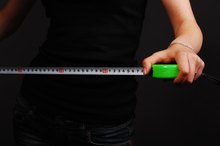What does fact checked mean?
At Healthfully, we strive to deliver objective content that is accurate and up-to-date. Our team periodically reviews articles in order to ensure content quality. The sources cited below consist of evidence from peer-reviewed journals, prominent medical organizations, academic associations, and government data.
- Harvard School of Public Health: Why Use BMI?
- Centers for Disease Control and Prevention: About Adult BMI
- Academy of Nutrition and Dietetics: Understanding Body Mass Index
The information contained on this site is for informational purposes only, and should not be used as a substitute for the advice of a professional health care provider. Please check with the appropriate physician regarding health questions and concerns. Although we strive to deliver accurate and up-to-date information, no guarantee to that effect is made.
The Reliability & Validity of BMI
Body mass index is used by health practitioners and organizations to provide a rough estimate of your body fat 3. It correlates to some degree with more accurate measurements, such as bioimpedance scales and DEXA X-ray scans, but can overestimate or underestimate fatness in certain populations.
BMI has its limitations, because it doesn't directly measure your fat, so it's not the most reliable or valid way of determining body fat levels. It's easy to figure and non-invasive, though, so it is useful as one of several screening tools to determine the appropriateness of a person's weight.
The Basics About BMI
To figure your BMI in American measurements, use an equation that includes a conversion factor: BMI = weight in pounds / (height in inches x height in inches) x 703. Many online calculators also exist. A BMI below 18.5 is considered underweight, while a BMI of 25 to 29.9 is overweight, and 30 or more is obese. A normal measurement falls between 18.5 and 24.9.
Your BMI measurement isn't a diagnosis.
But when your BMI is too high, it indicates to your doctor that you may need to undergo additional tests -- such as blood work, waist circumference measurements and skinfold caliper tests -- to make sure excessive fat isn't posing a risk to your health. A BMI that's too low indicates that you may not be getting all the calories and nutrients you need, so you may be at risk of low energy, poor immunity and vitamin and mineral deficiencies.
- To figure your BMI in American measurements, use an equation that includes a conversion factor: BMI = weight in pounds / (height in inches x height in inches) x 703.
- A BMI that's too low indicates that you may not be getting all the calories and nutrients you need, so you may be at risk of low energy, poor immunity and vitamin and mineral deficiencies.
BMI Accuracy
How Does a Scale Measure Body Fat?
Learn More
You and your friend may have the same BMI, but still have different levels of fatness. For example, when women and men have the same BMI, the woman usually has more fat because of hormonal differences.
Race can also affect BMI -- when at the same BMI, Caucasians tend to have more body fat than African-Americans and less than Asians. An older adult likely has a greater percentage of fat than a younger adult, even though both might have the same BMI. Sedentary people and athletes who have the same BMI also differ considerably in body fat percentage -- with athletes having lower levels.
The higher your BMI, the more likely it's accurately assessing an excessive amount of fat. Highly athletic people whose BMI falls into the higher side of normal or lower end of overweight may actually have a healthy amount of body fat, but an abundance of muscle that causes them to weigh more. Muscle is denser than fat, so it takes up less space pound for pound. You look lean and fit, but your BMI appears high. No need to be concerned, though; you aren't carrying excessive fat that increases your disease risk.
- You and your friend may have the same BMI, but still have different levels of fatness.
- Highly athletic people whose BMI falls into the higher side of normal or lower end of overweight may actually have a healthy amount of body fat, but an abundance of muscle that causes them to weigh more.
How and Where You Carry Weight Counts
Where you carry fat matters to your health, but BMI won't tell you this important detail.
BMI can't measure if you have a pear shape -- with more subcutaneous fat in your hips and thighs -- or an apple shape with a larger midsection. The large midsection can be of concern, because it may indicate that you have too much belly fat, also called visceral fat. Visceral fat can contribute to inflammation and may release compounds that raise your risk of serious health problems, such as type 2 diabetes and cardiovascular disease.
To make sure you're not carrying too much visceral fat, measure your waist to determine the circumference. A waist that's 40 or more inches for a man or larger than 35 inches for a woman indicates potentially dangerous levels of visceral fat.
People whose weight seems normal according to the BMI formula may still carry too much of those pounds as fat, especially if they're older, eat a nutrient-poor diet rich in fat and sugar, or are sedentary.
A man whose weight is normal but has 20-plus percent body fat, or a woman who has 30 percent, may be at risk of developing some of the same health issues as people who are significantly overweight. An estimated 30 million people fall into this category, Dr. Francisco Lopez-Jimenez, a Mayo Clinic cardiologist, told Today's Dietitian in 2011 5.
In these cases of normal weight obesity, BMI is not accurate nor reliable. Doctors ask about their patients' lifestyle habits and perform regular blood pressure, cholesterol and blood sugar screenings to help identify possible cases.
- Where you carry fat matters to your health, but BMI won't tell you this important detail.
- People whose weight seems normal according to the BMI formula may still carry too much of those pounds as fat, especially if they're older, eat a nutrient-poor diet rich in fat and sugar, or are sedentary.
Most Valid and Reliable Body Fat Measures
Scales That Measure BMI
Learn More
For a better understanding of how much fat your body contains, you can pursue more precise measuring methods.
Body fat scales are relatively easy to find at fitness centers and hospitals.
They use electrical impedance, which sends a mild electrical current through your body to measure fat versus lean mass. But their results can vary significantly, depending on your hydration levels and the quality of the machine.
A trained professional can use calipers to take skinfold thickness measurements at various locations on your body, including the upper arm, back of the waist and thigh.
The skinfold thickness indicates the amount of subcutaneous fat present at these various sites that is then used to estimate your body fat percentage. This testing is more accurate than BMI, but it's subject to the skill of the person taking the measurement.
Hydrostatic, or underwater, weighing and DEXA X-ray scans -- used primarily to analyze bone density -- are among the most accurate ways to determine your body fat.
Hydrostatic weighing carries a +/-1.5 percent margin for error, while DEXA scans are even more accurate; they are thus considered a "gold standard" in body fat analysis.
Both require special equipment, a health professional and a monetary investment. BMI correlates moderately with the results from these measures.
- For a better understanding of how much fat your body contains, you can pursue more precise measuring methods.
- Hydrostatic weighing carries a +/-1.5 percent margin for error, while DEXA scans are even more accurate; they are thus considered a "gold standard" in body fat analysis.
Related Articles
References
Writer Bio
Andrea Boldt has been in the fitness industry for more than 20 years. A personal trainer, run coach, group fitness instructor and master yoga teacher, she also holds certifications in holistic and fitness nutrition.









